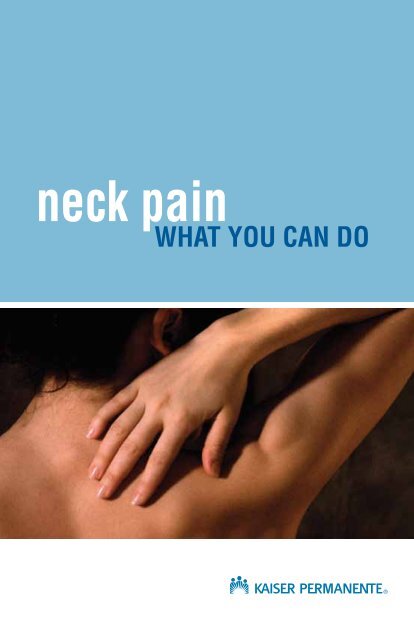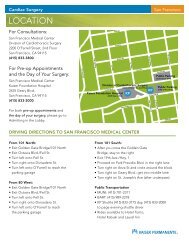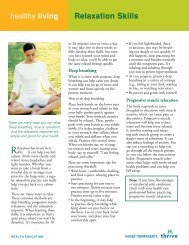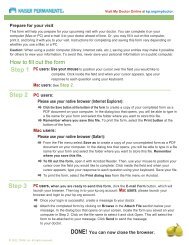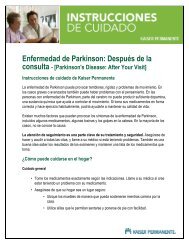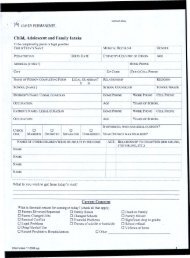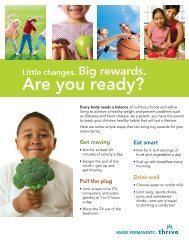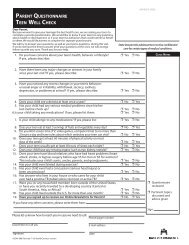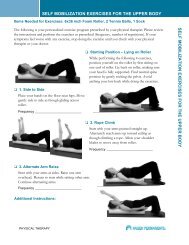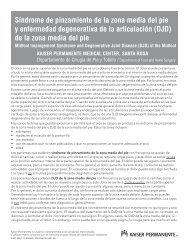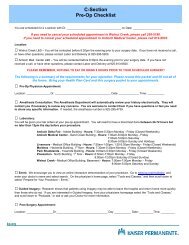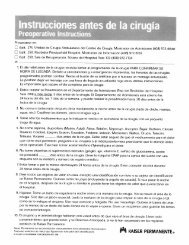neck pain: what you can do - My Doctor Online - Kaiser Permanente
neck pain: what you can do - My Doctor Online - Kaiser Permanente
neck pain: what you can do - My Doctor Online - Kaiser Permanente
Create successful ePaper yourself
Turn your PDF publications into a flip-book with our unique Google optimized e-Paper software.
<strong>neck</strong> <strong>pain</strong><br />
WHAT YOU CAN DO
Neck <strong>pain</strong><br />
Neck <strong>pain</strong> is a common problem. Nearly 25 percent of adults will experience<br />
<strong>neck</strong> <strong>pain</strong> at some time in their lives. Most of the time, <strong>neck</strong><br />
<strong>pain</strong> improves within 4 to 6 weeks. Even though <strong>neck</strong> problems <strong>can</strong><br />
be <strong>pain</strong>ful and frustrating, they are rarely caused by serious diseases.<br />
While there is no “quick fix” for <strong>neck</strong> <strong>pain</strong>, the good news is that <strong>you</strong><br />
<strong>can</strong> manage <strong>you</strong>r <strong>neck</strong> <strong>pain</strong> successfully.<br />
Where <strong>do</strong>es <strong>neck</strong> <strong>pain</strong> come from?<br />
The <strong>neck</strong> is made up of many<br />
different parts, including bones,<br />
joints, ligaments, discs, muscles,<br />
and nerves. Neck <strong>pain</strong> <strong>can</strong> begin<br />
in any of these areas. It <strong>can</strong> be felt<br />
in the <strong>neck</strong>, upper back, shoulders,<br />
or sometimes <strong>do</strong>wn the arm. Neck<br />
problems <strong>can</strong> also cause headaches.<br />
Bones – The bones in the <strong>neck</strong> are<br />
called vertebrae.<br />
Joints – A joint is formed where the<br />
vertebrae meet. These joints allow<br />
the spine to bend and move. Joints lose some of their ability to move<br />
as <strong>you</strong> age.<br />
Ligaments – Ligaments are strong bands that hold the bones together.<br />
When ligaments are pulled or over-stretched, it is called a sprain.<br />
Discs. Discs are made up of many layers. They separate the vertebrae<br />
and allow the <strong>neck</strong> to bend.<br />
Muscles. The muscles surrounding <strong>you</strong>r <strong>neck</strong> give it support and<br />
allow <strong>you</strong> to move. The muscles in the <strong>neck</strong> and upper back area<br />
are very important in helping to maintain good posture. When<br />
muscles are pulled or overworked, it is called a strain.<br />
1
Nerves – Nerves carry messages to the brain<br />
and control the muscles. The spinal nerves<br />
pass through small openings between the<br />
vertebrae. When irritated, they <strong>can</strong> cause<br />
<strong>pain</strong>, numbness, or tingling in the arm.<br />
What makes it hurt?<br />
Most <strong>neck</strong> <strong>pain</strong> results from irritation or injury to one or more of the<br />
parts of the <strong>neck</strong> described above. Most commonly this is caused by:<br />
• Poor sitting posture while working at <strong>you</strong>r desk or computer; or<br />
while reading or driving.<br />
• Stressful work or home situations that increase the tension in the<br />
<strong>neck</strong> muscles.<br />
• Sleeping in an awkward position.<br />
• Looking up repeatedly while <strong>do</strong>ing tasks such as <strong>pain</strong>ting or<br />
trimming trees.<br />
• Changes in <strong>neck</strong> alignment due to eye wear.<br />
• Changes to the normal condition of the joints and discs over time.<br />
What <strong>can</strong> I <strong>do</strong> to help my <strong>neck</strong>?<br />
FIRST AID<br />
Use ice to reduce <strong>pain</strong> and inflammation.<br />
Apply ice for 10 to 20 minutes, several times<br />
per day. You may use heat to ease muscle tension<br />
and <strong>pain</strong>. If <strong>you</strong> have diabetes or circulatory<br />
problems, limit use of ice or heat to 10 minutes.<br />
Take medications as directed. Common<br />
medications are acetaminophen (such as Tylenol) and non-steroidal<br />
anti-inflammatory drugs (such as Motrin / ibuprofen or Aleve / naproxen<br />
sodium). When taking anti-inflammatory drugs as prescribed, it will<br />
take 10 to 14 days for them to become fully effective. Talk to <strong>you</strong>r<br />
<strong>do</strong>ctor about prescription medication.<br />
2
Reduce the stress and strain on <strong>you</strong>r <strong>neck</strong><br />
Use good posture and body positions. Proper alignment of <strong>you</strong>r head,<br />
<strong>neck</strong>, and back is the key to spinal comfort. If <strong>you</strong> slouch, <strong>you</strong>r chin<br />
will tend to protrude forward and cause <strong>you</strong>r shoulders to round. This<br />
“forward head posture” <strong>can</strong> produce or increase <strong>neck</strong> and shoulder<br />
tension and <strong>pain</strong>.<br />
SITTING<br />
• Limit sitting unsupported or in one position to<br />
less than 30 minutes.<br />
• Sit all the way back in the chair with <strong>you</strong>r feet flat<br />
on the floor (or, use a foot stool).<br />
• Place a rolled towel between the chair and <strong>you</strong>r<br />
lower back.<br />
• Keep <strong>you</strong>r chest up. (Think about making <strong>you</strong>rself taller.)<br />
• If a chair with armrests is not available, place 1 or 2 pillows on <strong>you</strong>r<br />
lap to support <strong>you</strong>r arms.<br />
COMPUTER USE<br />
• Sit up straight with hips, shoulders, and<br />
head facing the monitor.<br />
• Adjust <strong>you</strong>r chair to bring <strong>you</strong>r hips<br />
slightly higher than <strong>you</strong>r knees.<br />
• Keep both feet flat on the floor or on a<br />
footrest.<br />
• Adjust <strong>you</strong>r monitor so the top fourth<br />
is level with <strong>you</strong>r eyes. (If <strong>you</strong> wear<br />
progressive lenses, <strong>you</strong> may need to adjust the monitor lower.)<br />
• To avoid eye strain: For every 20 minutes of computer use,<br />
look at least 20 feet away for 20 seconds.<br />
3
READING<br />
• Avoid reading in bed with <strong>you</strong>r head and <strong>neck</strong> propped on pillows.<br />
• Hold materials up to allow <strong>you</strong> to look straight ahead.<br />
• Use a slant board for desktop activities.<br />
• Use arm rests or pillows to support <strong>you</strong>r arms.<br />
TELEPHONE USE<br />
• Avoid tilting <strong>you</strong>r head sideways<br />
to hold the phone.<br />
• Use a headset.<br />
STANDING<br />
• Use good standing posture to protect <strong>you</strong>r <strong>neck</strong>.<br />
• If <strong>you</strong> have arm <strong>pain</strong>, place <strong>you</strong>r hand on the<br />
counter or in <strong>you</strong>r pocket.<br />
• Place one foot on a stool.<br />
REACHING<br />
• Avoid repetitive reaching or looking up for long<br />
periods of time.<br />
• When reaching, stand as close to the item as <strong>you</strong> <strong>can</strong>.<br />
• If <strong>you</strong> have to reach for a shelf higher than <strong>you</strong>r<br />
head, stand on a stool.<br />
• Tighten <strong>you</strong>r stomach muscles when reaching up.<br />
• Look up with <strong>you</strong>r eyes; avoid tipping <strong>you</strong>r head back.<br />
4
BENDING<br />
The “hip hinge” is used to move correctly<br />
while bending or lifting. Some examples<br />
include brushing <strong>you</strong>r teeth, vacuuming,<br />
or gardening. To perform the “hip hinge,”<br />
bend from the hips rather than the low back.<br />
Avoid bringing <strong>you</strong>r head forward<br />
and rounding <strong>you</strong>r back when<br />
<strong>you</strong> bend and lift.<br />
LIFTING<br />
To maintain good alignment while lifting:<br />
• Bend <strong>you</strong>r knees and lift with <strong>you</strong>r legs.<br />
• Gently tighten <strong>you</strong>r stomach muscles.<br />
• Keep the load as close to <strong>you</strong>r body as possible.<br />
• If <strong>you</strong> must lift large or awkward loads,<br />
get help.<br />
• Do not attempt lifting if <strong>you</strong>r symptoms are<br />
new or severe.<br />
• If <strong>you</strong> experience <strong>pain</strong> with lifting, stop.<br />
5
SLEEPING<br />
On <strong>you</strong>r back<br />
Lying on <strong>you</strong>r back <strong>can</strong> be the best position when <strong>you</strong> have <strong>neck</strong> <strong>pain</strong>:<br />
• Support the curve of <strong>you</strong>r <strong>neck</strong> with a small towel roll. If <strong>you</strong> use<br />
a pillow, place the towel roll inside the pillow case at its base.<br />
• Use 1–3 pillows under <strong>you</strong>r thighs<br />
and knees to keep <strong>you</strong>r spine<br />
in a more comfortable position.<br />
• If <strong>you</strong> have a <strong>pain</strong>ful shoulder/arm, use a pillow to prop the arm up<br />
and allow <strong>you</strong>r hand to rest across <strong>you</strong>r chest or stomach.<br />
Side-lying<br />
In side-lying, it is important to maintain <strong>you</strong>r neutral spine position.<br />
Your head and <strong>neck</strong> should be in the same position, as if <strong>you</strong> were<br />
standing up looking straight ahead.<br />
• Place a pillow and towel roll<br />
supporting <strong>you</strong>r <strong>neck</strong> and head.<br />
• Place a pillow between <strong>you</strong>r knees.<br />
• Place <strong>you</strong>r arm on a pillow.<br />
On <strong>you</strong>r stomach<br />
You should not lie on <strong>you</strong>r stomach, since this position places <strong>you</strong>r<br />
<strong>neck</strong> at an awkward angle and may increase <strong>you</strong>r symptoms.<br />
EXERCISE REGULARLY<br />
It is okay to rest for 1 to 3 days after a new injury. Too much bed rest<br />
<strong>can</strong> make <strong>you</strong>r <strong>neck</strong> <strong>pain</strong> worse and delay <strong>you</strong>r recovery. People who<br />
are physically active recover more quickly, and have less frequent <strong>neck</strong><br />
problems. It is helpful to continue light and easy activity, as long as<br />
<strong>you</strong>r symptoms <strong>do</strong>n’t worsen.<br />
Your exercise program should include:<br />
• aerobic exercise (walking, stationary bike)<br />
• hourly postural exercises<br />
• <strong>neck</strong> range of motion exercises<br />
• strengthening (as <strong>you</strong> improve)<br />
• relaxation<br />
6
Exercises to improve <strong>you</strong>r <strong>neck</strong> <strong>pain</strong><br />
AEROBIC EXERCISES<br />
WALKING<br />
• Take short walks several times during the day.<br />
• Wear athletic shoes.<br />
• Avoid carrying heavy items on <strong>you</strong>r shoulders or in <strong>you</strong>r arms.<br />
HOURLY POSTURAL EXERCISES: STEPS 1 – 4<br />
It is important to maintain good posture throughout the day. Good<br />
posture means maintaining the natural curves in <strong>you</strong>r <strong>neck</strong> and back<br />
or the “neutral spine” position. This is also the most comfortable<br />
position for <strong>you</strong>r <strong>neck</strong> and back. The following steps will help <strong>you</strong> to<br />
find and maintain good posture throughout the day. Your posture will<br />
improve if <strong>you</strong> continue to <strong>do</strong> these exercises.<br />
Do the following four steps in orDer.<br />
repeat 5 times each hour.<br />
STEP 1: FIND YOUR NEUTRAL BACK POSITION<br />
• Sit near the edge of <strong>you</strong>r chair.<br />
• Rock <strong>you</strong>r hips forward until<br />
<strong>you</strong>r back arches.<br />
• Rock hips back, noticing<br />
the arch disappear.<br />
• Rock forward and back until<br />
<strong>you</strong> find the amount of arch<br />
that is comfortable for <strong>you</strong>. This<br />
is <strong>you</strong>r neutral position for <strong>you</strong>r<br />
low back.<br />
• Keep <strong>you</strong>r chest up. (Think about<br />
making <strong>you</strong>rself taller.)<br />
7
STEP 2: SHOULDER CLOCK<br />
• Start with <strong>you</strong>r arms relaxed at sides.<br />
• Raise shoulders toward <strong>you</strong>r ears.<br />
• Hold for 2 seconds.<br />
• Rotate shoulders back and <strong>do</strong>wn.<br />
• Hold for 2 seconds.<br />
• Slowly return to start position.<br />
STEP 3: SHOULDER BLADE SQUEEZE<br />
• Start with <strong>you</strong>r arms relaxed<br />
at <strong>you</strong>r sides.<br />
• Rotate <strong>you</strong>r arms outward, palms<br />
forward while gently squeezing<br />
<strong>you</strong>r shoulder blades.<br />
• Hold for 5 seconds.<br />
• Slowly return to start position.<br />
STEP 4: DROPPING YOUR CHIN<br />
• Gently drop <strong>you</strong>r chin<br />
• Think about lengthening the back<br />
of <strong>you</strong>r <strong>neck</strong> to become tall.<br />
8
NECK RANGE OF MOTION EXERCISES<br />
These gentle exercises are used to restore or maintain <strong>neck</strong> movement.<br />
You should feel a gentle pull with no increase in <strong>you</strong>r symptoms.<br />
Remember to breathe normally and relax.<br />
For each of the exercises, <strong>do</strong> the following:<br />
• Begin each exercise with good posture.<br />
• Begin with small movements.<br />
• Hold 5 seconds.<br />
• Repeat 5 times.<br />
• Do 2 times per day.<br />
CHIN TO CHEST<br />
• Gently move <strong>you</strong>r chin towards <strong>you</strong>r chest.<br />
• Optional: Focus <strong>you</strong>r eyes on a stationary object<br />
throughout movement.<br />
HEAD TURNS<br />
• Start facing forward.<br />
• Turn <strong>you</strong>r head to look towards one shoulder.<br />
• Repeat for both sides.<br />
• Optional: Focus <strong>you</strong>r eyes on a stationary object<br />
throughout movement.<br />
9
NECK STRENGTHENING EXERCISES – Isometrics<br />
Isometric exercises cause gentle contraction of the muscles without<br />
movement. These exercises should not cause an increase in <strong>you</strong>r<br />
symptoms. Remember to breathe normally and relax.<br />
For each of the isometric exercises, <strong>do</strong> the following:<br />
• Begin exercise with good posture.<br />
• Hold for 5 – 10 seconds.<br />
• Repeat 5 times.<br />
• Do 2 times per day.<br />
ISOMETRIC HEAD NOD<br />
• Start facing forward.<br />
• With thumb supporting <strong>you</strong>r chin, gently nod <strong>you</strong>r head<br />
while applying gentle pressure upwards.<br />
• Your head should not move.<br />
10
ISOMETRIC SIDE BENDS<br />
• Start facing forward.<br />
• Place <strong>you</strong>r index and middle fingers<br />
on the side of <strong>you</strong>r head above <strong>you</strong>r ears.<br />
• Gently press <strong>you</strong>r head towards <strong>you</strong>r<br />
fingers as <strong>you</strong> apply gentle pressure.<br />
• Your head should not move.<br />
ISOMETRIC TURNING<br />
• Start facing forward.<br />
• Place <strong>you</strong>r index and middle fingers<br />
on the side of <strong>you</strong>r head by <strong>you</strong>r eyebrow.<br />
• Move <strong>you</strong>r eyes towards <strong>you</strong>r<br />
fingers as <strong>you</strong> apply gentle pressure.<br />
• Your head should not move.<br />
11
RELAXATION EXERCISES<br />
DEEP BREATHING<br />
• Find a comfortable position sitting, standing, or lying on <strong>you</strong>r back.<br />
• Place one hand on <strong>you</strong>r lower stomach and the other hand on <strong>you</strong>r<br />
upper chest.<br />
• Breathe in through <strong>you</strong>r nose. As <strong>you</strong> breathe in, <strong>you</strong> should feel<br />
<strong>you</strong>r stomach rising. (If <strong>you</strong> <strong>can</strong>’t breathe in through <strong>you</strong>r nose,<br />
then breathe in through <strong>you</strong>r mouth.)<br />
• Breathe out slowly through <strong>you</strong>r pursed lips. Let the air flow slowly.<br />
Do not force it out. It should take twice as long to exhale as it <strong>do</strong>es<br />
to inhale.<br />
Headache <strong>pain</strong> related to the <strong>neck</strong><br />
Some headaches may start in the <strong>neck</strong>. These headaches are often<br />
caused by prolonged poor posture or stress. Increased tension in the<br />
<strong>neck</strong> muscles or <strong>neck</strong> injuries may lead to headaches.<br />
Helpful techniques to reduce headache <strong>pain</strong>:<br />
• Self massage the base of <strong>you</strong>r skull.<br />
• Apply gentle pressure to points where <strong>you</strong> feel <strong>pain</strong> or tightness.<br />
• Apply an ice pack to the base of <strong>you</strong>r skull.<br />
• Lie with a rolled towel under <strong>you</strong>r <strong>neck</strong> and gently nod <strong>you</strong>r head.<br />
12
THE ROLE OF STRESS IN NECK AND HEADACHE PAIN<br />
An increase in stress may cause more muscle tightness in <strong>you</strong>r <strong>neck</strong>.<br />
This <strong>can</strong> cause <strong>neck</strong> and headache <strong>pain</strong>. There are a number of stress<br />
reduction methods that may help:<br />
• Walking<br />
• Deep breathing<br />
• Relaxation exercises<br />
• Guided imagery – this uses body awareness and visualization<br />
of pleasant or positive images<br />
• Meditation<br />
• Self hypnosis<br />
• Gentle yoga stretching<br />
To listen to or to <strong>do</strong>wnload podcasts about some of the topics mentioned<br />
above, visit <strong>you</strong>r physician’s Home Page at kp.org/my<strong>do</strong>ctor. Click<br />
on “Podcasts” under “Healthy Living Resources” on the left side of<br />
the screen.<br />
Get a personalized headache program. “Managing Your Headaches”<br />
is an online, interactive education program that provides <strong>you</strong> with<br />
prevention information, self-care tools, and action plans that <strong>can</strong> help<br />
<strong>you</strong> manage <strong>you</strong>r headache symptoms. Visit <strong>you</strong>r physician’s Home<br />
Page at kp.org/my<strong>do</strong>ctor and get started today.<br />
Smoking<br />
People who smoke tend to have more <strong>neck</strong> and back problems, and it<br />
takes longer for them to get better. Smoking interferes with the blood<br />
flow and the healing of tissues. Quitting smoking is one of the best<br />
things <strong>you</strong> <strong>can</strong> <strong>do</strong> to improve <strong>you</strong>r health. We know that quitting<br />
smoking is hard to <strong>do</strong>. That’s why <strong>Kaiser</strong> <strong>Permanente</strong> offers effective<br />
support through quit smoking classes, over the phone, online, or in<br />
person with a counselor. These services are available at no additional<br />
cost. When <strong>you</strong> participate, <strong>you</strong> are able to get smoking cessation<br />
medications at <strong>you</strong>r drug benefit co-pay. Call <strong>you</strong>r Health Education<br />
Department or visit kp.org/quitsmoking for more information.<br />
13
Call <strong>you</strong>r <strong>do</strong>ctor if:<br />
• You develop new symptoms (weakness, numbness or <strong>pain</strong>) in the<br />
arms or legs.<br />
• Your <strong>pain</strong> has lasted 2 weeks or longer despite home treatment.<br />
• You have a severe headache that strikes suddenly without apparent<br />
cause or is very different from previous headaches.<br />
Other resources<br />
For more health information:<br />
• Connect to our Web site at kp.org to access health and drug<br />
encyclopedias, interactive programs, health classes, and much more.<br />
• Contact <strong>you</strong>r <strong>Kaiser</strong> <strong>Permanente</strong> Health Education Center or<br />
Department for health information, programs, and other resources.<br />
14
This information is not intended to diagnose health problems or to take the place of<br />
medical advice or care <strong>you</strong> receive from <strong>you</strong>r physician or other health care professional.<br />
If <strong>you</strong> have persistent health problems, or if <strong>you</strong> have additional questions, please consult<br />
with <strong>you</strong>r <strong>do</strong>ctor. <strong>Kaiser</strong> <strong>Permanente</strong> <strong>do</strong>es not en<strong>do</strong>rse the medications or products<br />
mentioned. Any trade names listed are for easy identification only.<br />
© 2005, The <strong>Permanente</strong> Medical Group, Inc. All rights reserved.<br />
Regional Health Education<br />
9134000104 (Revised 9-10) RL 5.7


